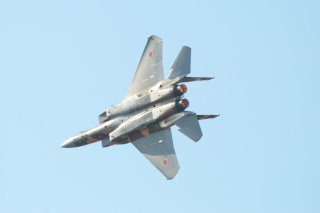Japan Wants Its Fighters to Carry More Missiles than an F-35
While Tokyo mulls its options, Lockheed is trying to squeeze more missiles into the F-35’s bays.
Here’s What You Need to Remember: If Japan wants its new F-3 fighter to carry more missiles, it will need to develop a stealth fighter with a layout similar to the F-22 or acquire a non-stealthy plane in a similar class as the F-15EX. Not coincidentally, Lockheed has proposed to co-develop with Japanese industry an F-3 design that combines the airframe of the F-22 stealth fighter with the F-35’s sensors and electronics.
Japanese Defense Minister Taro Kono said the country’s next fighter plane must carry more air-to-air missiles than the current Lockheed Martin F-35 stealth fighter can do.
"We will emphasize network functions and demand high stealth performance, Kono told reporters. “It will carry more missiles than the F-35."
The requirement should come as no surprise. The F-35’s comparatively small weapons capacity while in stealth mode is one of its operators’ biggest complaints. The conventional-takeoff F-35A in its current configuration can carry just four AIM-120 air-to-air missiles in its internal bays.
External weapons are a major booster of a plane’s radar signature. To remain stealthy, a radar-evading fighter must carry its munitions internally. But that can impose limits on a plane’s loadout that can put it at a disadvantage in a pitched fight where every missile counts.
Older, non-stealthy Russian and Chinese fighters in certain configurations can carry a dozen or more air-to-air missiles. Russia’s Su-57 stealth fighter and China’s J-20 stealth fighter apparently can pack six missiles in their internal bays. The U.S. Air Force’s F-22, also a Lockheed product, can fit eight missiles in its bays.
The superior missile capacity of a conventional fighter design weighed on the U.S. Air Force’s decision to begin buying upgraded Boeing F-15EXs in parallel with ongoing purchases of F-35s. The Air Force in 2020 is acquiring the first eight of up to 144 F-15EX. The service already operates around 200 F-35As and has been buying additional copies at a rate of around 50 per year. An F-15EX and an F-35A both cost around $100 million.
Where the F-35 maxes out at just four air-to-air missiles, the F-15EX could, in a pinch, haul a whopping 22 missiles, according to Boeing test pilot Matt Geise.
Twenty-two missiles would impose a weight and drag penalty that makes such a loadout unattractive for normal operations. But even with a much smaller missile load, an F-15EX easily could carry into battle twice or three times as many missiles as an F-35 can do.
If Japan wants its new F-3 fighter to carry more missiles, it will need to develop a stealth fighter with a layout similar to the F-22 or acquire a non-stealthy plane in a similar class as the F-15EX.
Not coincidentally, Lockheed has proposed to co-develop with Japanese industry an F-3 design that combines the airframe of the F-22 stealth fighter with the F-35’s sensors and electronics. But it’s worth noting that Japan already operates around 200 older F-15Js.
While Tokyo mulls its options, Lockheed is trying to squeeze more missiles into the F-35’s bays. “With internal research and development over the last several years, Lockheed Martin has matured design concepts to integrate six air-to-air missiles within the internal weapons bays of the F-35A and F-35C variants,” company spokesman Michael Friedman told Breaking Defense.
“This effort allows further enhancement of the F-35’s lethality and survivability by increasing internal weapons capacity by two additional missiles while remaining in very-low-observable stealth configuration.”
But the concept requires modifications to the F-35’s internal layout. It’s not clear whether any F-35-operator yet has been willing to pay for the changes.
David Axe served as Defense Editor of the National Interest. He is the author of the graphic novels War Fix, War Is Boring and Machete Squad.
This article is being republished due to reader interest.
Image: Wikimedia Commons.

